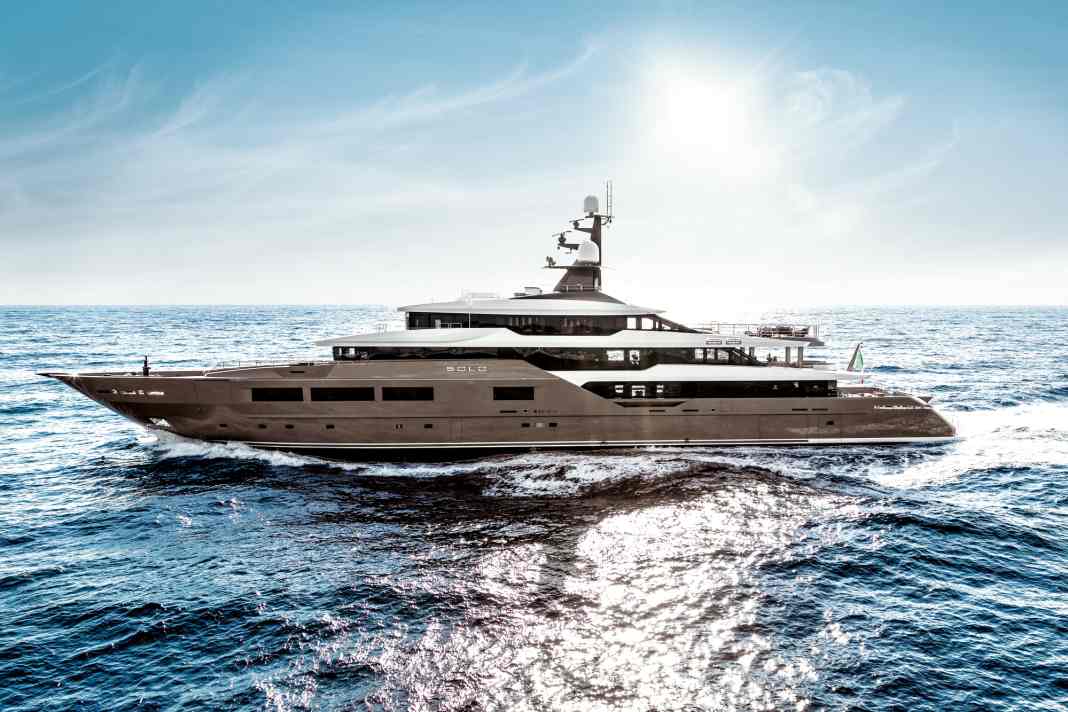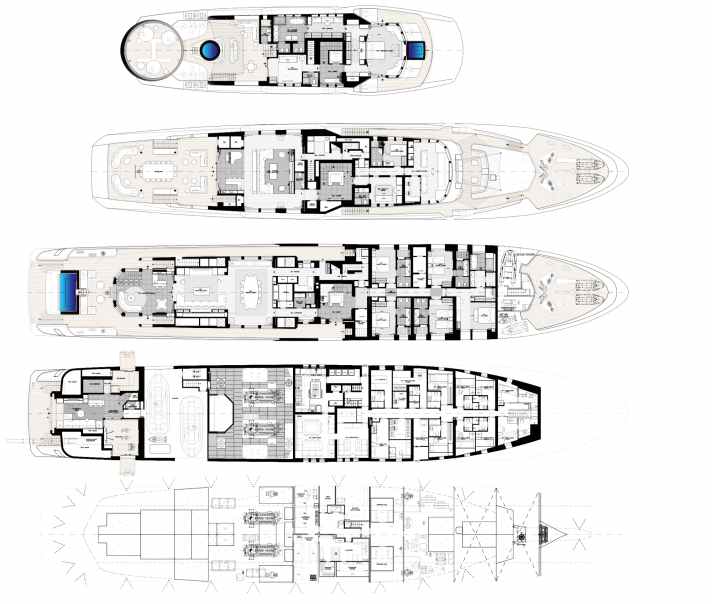





When you think of Italy and technology, you almost inevitably end up with the phenomenon of the "bella macchina". Aesthetics and lifestyle are known to take precedence in the country south of the Alps, which is why the appliances created there, from espresso machines to sports cars, are above all one thing: graceful things. However, if we talk about the "cooler" engineering virtues such as perfection, efficiency and quality of detail, then the Italian temperament is not necessarily always the first port of call. However, Tankoa Yachts wants to prove that this assumption is a historical stereotype without foundation. If in doubt, they will go it alone, solo, so to speak.
The safest way to dispel prejudices is to create reliable facts, as Michel Karsenti knows. "Since the start of the project, we have communicated our ambition to go head-to-head with the best northern European producers," says Tankoa's Marketing Director. "By the best northern European producers, we primarily mean Dutch and German shipyards," adds Karsenti with a wink. "We have transferred this competitive incentive to our project managers, engineers and boat builders. It made a big impression on everyone." Albert McIlroy, who represents the owner, humorously confirms the committed atmosphere of the Italian team: "It felt like working with a Northern European shipyard, except that there are also world-class restaurants around the corner."
Special wishes of the buyers only after the shell construction
Tankoa, with its headquarters and shipyard in Genoa, is benefiting from the favourable market situation in the large yacht sector. The shipyard can afford to produce on spec, i.e. even without an order from a buyer, which considerably reduces waiting times for impatient potential buyers. Buyers then only make their special requests after the shell has been built. The fact that the shipyard has already set itself such ambitious goals on the starting block is having an effect. After the first sea trials in the Mediterranean, but before the final handover to the owner, "Solo" won the "Most efficient Yacht of the Year" award (2019) in Cannes. The fact that "Solo" is one of the most efficient and technically sustainable large formats that have been ploughing the seas since the end of last year is thanks to a combination of numerous innovative technologies. Firstly, there is the emission-reduced drive technology with Ecospray SCR (Selective Catalytic Reduction), permanent CO2 monitoring and exemplary noise reduction. "Solo" also comes with a certified environmental management plan, which helps to avoid any unnecessary environmental impact during the yacht's operation. Furthermore, the entire construction was carried out in compliance with structural plans in accordance with the nautical B5 rule, which requires the highest level of maritime safety and according to which the individual fuel tanks must not be larger than 36 cubic metres. This also means that in the event of a collision, the possibility of diesel escaping has been greatly minimised by safety tanks. The consensus at the Genoa shipyard is that so much optimisation of safety and efficiency should not be a brake on fun. Despite its low fuel consumption, the two Caterpillar engines, each with an output of 1825 kilowatts, leave no doubt that the five-decker with a displacement of 1250 tonnes and a top speed of 17.5 knots will set the pulse of any yacht aficionado racing.
"Solo" should be aesthetic
The all-round impressive complete technical package speaks for the fact that engineer Vincenzo Ruggiero and designer Francesco Paszkowski have certainly achieved far more than just a "beautiful little machine" with the "Solo". And yet the traditional Italian talent for elegant design has not been neglected in any respect. The rather young owner also made it easy, says Paszkowski. His instructions were direct and to the point. The aim was to achieve a high degree of aesthetic independence between the exterior and interior. Right from the start, the owner declared that the often experienced break in yachts - racy sports equipment on the outside, over-decorated box of chocolates on the inside - was taboo. In addition, the desire for a certain classicism. Externally, this is evident at a glance: a strongly projecting stem, centred superstructure and horizontally emphasised deck structure. In addition, the aft line is staged as a sloping diagonal, window strips in cinema format and monochrome throughout the colour scheme. It doesn't get much more modern classic than this.
Strong duo: Tankoa Yachts collaborates with Italian architect
Margherita Casprini was appointed to interpret this design language and continue it inwards. The Italian, who sees herself as an independent yacht architect but regularly collaborates with Paszkowski, already scored with "Vertige", a 50 metre Tankoa model. Her move in this case: a masculine club style - matter-of-fact, pure and with an explicit understatement that does justice to the cool exterior. Casprini emphasises lines and surfaces; the feeling clearly comes from the material and not from applications or decorative flourishes. The interior is characterised by earthy natural tones such as raw silk, sand, mocha, ebony or bronze. The modernist, minimalist design language gives Casprini plenty of room to showcase details. Three types of marble from France and India and white onyx from Mexico alone are harmonised in a nuanced way. A high-contrast finish can be experienced in the wooden surfaces, the grey and black oak of the room panels have a satin finish, the floor made of Macassar ebony stands out in a high-gloss look. The matching seating, mostly in leather, is supplied by trendsetter Fendi Roma. It is almost reminiscent of a cool Manhattan loft if the designer had not added the kind of accents that are unique to the Italian style. For example, she commissioned the artist Dario Tironi to create a sculpture that can only be described as deliberately provocative in this context. A life-size figurine, whose body has been collaged from plastic parts of discarded electrical appliances and found pieces of brightly coloured children's toys, sits casually on a sideboard. Wild pop art amidst the restrained elegance of classic materials - designers of chocolate box interiors would never dare to do something like this.
Elegant ballroom atmosphere
However, the classic overall layout of the Italian yacht brings considerable advantages in terms of space. This is noticeable on the upper deck. From the beach club with a transversal pool and an outdoor cinema, there is a seemingly seamless transition to the bright conservatory, which houses a lounge and bar area. From there, you enter the large salon and finally the dining area, which is closed off by a panoramic aquarium. So much generosity creates a ballroom atmosphere, as if Margherita Casprini had planned not just for twelve select guests, but for an entire party. Room transparency, not always a trend in yacht building, was expressly emphasised as a design feature. If desired, the elongated interior can be divided into three independent sections by means of movable panels. Communication and movement between outside and inside is thus carefully tempered depending on the application. Thanks to a slight length advantage that "Solo" has over the three years younger Sister ship "Suerte" Both designs are based on the same S701 model platform - the entire room concept is even more airy. This is clearly evident in the bulwarks, which are lowered almost to floor level: the saloon is flooded with light. A generously designed crew area with an XXL galley can also be realised as a result and benefits the 18-strong crew. The idea of openness in general and flexible separation when required is also continued on the other decks. In addition to the owner's suite and the VIP suite, there are four guest cabins, two of which can be reconfigured as required.
The gym and spa are directly accessible from the beach club. Here, glass walls create the feeling of a spacious whole, and here, too, you can set yourself apart if you wish. Above all, setting off means sitting out. A terrace can be extended to the side and invites you to sunbathe. After a work-out, of course.
The paperless bridge
The lift takes you through the lobby to the upper deck. Ahead awaits what always gives nautical traditionalists a queasy feeling: the completely paperless bridge. With no charts, instruments or compass visible at first glance, navigation and control over the concentrated efficiency of the "Solo" is purely digital. The helm station is from Böning and has been certified by Lloyd's Register and RINA. Multiple redundant systems guarantee that command capability is maintained even in the unlikely event of a failure of the three generators.
The beauty parlour is located behind the bridge and captain's cabin. A room with lounge qualities, where the ladies can take care of themselves and of course their beauty, was the express wish of the owner. The upper saloon is casually grouped around a flat fireplace, which creates a cosy feeling, especially in colder climes.
Floor-to-ceiling panoramic windows and an accompanying piano bar with a gleaming Steinway grand piano bring guests and owners together in the evening. An additional galley, the privilege of large yachts, has been provided so that evening meals can also be served here in smaller groups. The advantages: no unnecessary walking distances for the crew and a deliberately intimate atmosphere.
Tankoa Yachts integrates clever space concept
Another clever space concept can be found aft on the owner's deck. The helipad was designed as a touch-and-go platform. Simply touch down, get in or out and the Aerotender is on its way again. It has been fully lined with teak and can therefore serve as an additional open deck the rest of the time.
At the very top of the fly deck, Margherita Casprini makes another purist statement. Nothing should disturb the enjoyment of the sun and the view, except perhaps a little airstream. A seating area under the awning and two spacious sun loungers - that's all that's needed, and that's all it should be.
After "Solo" had been tested, presented and showered with prizes, the Tankoa flagship returned to the shipyard for some final work. After a short stay in Genoa, "Solo" then set off on her first voyage. The maiden voyage took her across the Atlantic to spend the winter season in the Caribbean between the Bahamas and Trinidad. Of course, the toy collection was also used there. In addition to two large tenders, the owner and his guests have a wide range of water sports equipment to choose from in the garage. Three powerful jet skis are also parked on the foredeck, which are transported by telescopic crane to their destination: the wet Caribbean azure.
The captain had great fun planning the trip and the owner - so we hear - enjoys his yacht to the full. In response to the final question about the "Solo's" greatest qualities, the captain replies almost shyly: "She is a beauty." Which brings us back to the classic Italian design virtue.
Technical data

- Length over everything:72 m
- Width:11,60 m
- Depth:3,38 m
- Displacement (empty): 1250 t
- Material: Steel, aluminium
- Motor:2 x CAT 3516
- Engine power:2 x 1825 kW
- Speed (max.): 17.5 kn
- Range @ 12 kn: 6000 nm
- Fuel:162 000 l
- Generators: Northern Light 2 x 230 kW, 1 x 155 kW
- Navigation:Böning
- Bow thruster:Naiad, 200 kW
- Stabiliser: Naiad, Zero Speed
- Exterior design: F. Paszkowski
- Interior design:F. Paszkowski and M. Casprini
- Construction: V. Ruggiero, Tankoa
- Design category:Lloyd's Register, RINA, MCA, LY3
- Shipyard: Tankoa, 2018
This article appeared in BOOTE EXCLUSIV issue 3/2019 and was revised by the editorial team in June 2023.

